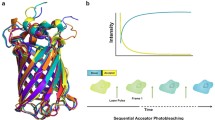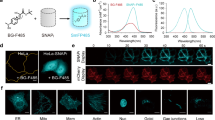Abstract
Fluorescent proteins are commonly used to label target proteins in live cells. However, the conventional approach based on covalent fusion of targeted proteins with fluorescent protein probes is limited by the slow rate of fluorophore maturation and irretrievable loss of fluorescence due to photobleaching. Here, we report a genetically encoded protein labeling system utilizing transient interactions of small, 21–28 residues-long helical protein tags (K/E coils, KEC). In this system, a protein of interest, covalently tagged with a single coil, is visualized through binding to a cytoplasmic fluorescent protein carrying a complementary coil. The reversible heterodimerization of KECs, whose affinity can be tuned in a broad concentration range from nanomolar to micromolar, allows continuous exchange and replenishment of the tag bound to a targeted protein with the entire cytosolic pool of soluble fluorescent coils. We found that, under conditions of partial illumination of living cells, the photostability of labeling with KECs exceeds that of covalently fused fluorescent probes by approximately one order of magnitude. Similarly, single-molecule localization microscopy with KECs provided higher labeling density and allowed a much longer duration of imaging than with conventional fusion to fluorescent proteins. We also demonstrated that this method is well suited for imaging newly synthesized proteins, because the labeling efficiency by KECs is not dependent on the rate of fluorescent protein maturation. In conclusion, KECs can be used to visualize various target proteins which are directly exposed to the cytosol, thereby enabling their advanced characterization in time and space.




Similar content being viewed by others
References
Spahn C, Grimm JB, Lavis LD, Lampe M, Heilemann M (2018) Whole-cell, 3D and multi-color STED imaging with exchangeable fluorophores. Nano Lett 19:500–505
Kiuchi T, Higuchi M, Takamura A, Maruoka M, Watanabe N (2015) Multitarget super-resolution microscopy with high-density labeling by exchangeable probes. Nat Methods 12:743–746
Bozhanova NG et al (2017) Protein labeling for live cell fluorescence microscopy with a highly photostable renewable signal. Chem Sci 8:7138–7142
Riedl J et al (2008) Lifeact: a versatile marker to visualize F-actin. Nat Methods 5:605–607
Schell MJ, Erneux C, Irvine RF (2001) Inositol 1,4,5-trisphosphate 3-kinase A associates with F-actin and dendritic spines via its N terminus. J Biol Chem 276:37537–37546
Olson KR, McIntosh JR, Olmsted JB (1995) Analysis of MAP 4 function in living cells using green fluorescent protein (GFP) chimeras. J Cell Biol 130:639–650
Yano Y et al (2008) Coiled-coil tag-probe system for quick labeling of membrane receptors in living cells. ACS Chem Biol 3:341–345
Tsutsumi H et al (2009) Fluorogenically active leucine zipper peptides as tag-probe pairs for protein imaging in living cells. Angew Chem Int Ed Engl 48:9164–9166
Chao H et al (1996) Kinetic study on the formation of a de novo designed heterodimeric coiled-coil: use of surface plasmon resonance to monitor the association and dissociation of polypeptide chains. Biochemistry 35:12175–12185
Yano Y, Matsuzaki K (2019) Live-cell imaging of membrane proteins by a coiled-coil labeling method—principles and applications. Biochim Biophys Acta Biomembr 1861:1011–1018
Litowski JR, Hodges RS (2002) Designing heterodimeric two-stranded alpha-helical coiled-coils. Effects of hydrophobicity and alpha-helical propensity on protein folding, stability, and specificity. J Biol Chem 277:37272–37279
Weidemann T et al (2003) Counting nucleosomes in living cells with a combination of fluorescence correlation spectroscopy and confocal imaging. J Mol Biol 334:229–240
Costantini LM, Fossati M, Francolini M, Snapp EL (2012) Assessing the tendency of fluorescent proteins to oligomerize under physiologic conditions. Traffic 13:643–649
Cranfill PJ et al (2016) Quantitative assessment of fluorescent proteins. Nat Methods 13:557–562
Lippincott-Schwartz J, Snapp E, Kenworthy A (2001) Studying protein dynamics in living cells. Nat Rev Mol Cell Biol 2:444–456
Sharonov A, Hochstrasser RM (2006) Wide-field subdiffraction imaging by accumulated binding of diffusing probes. Proc Natl Acad Sci USA 103:18911–18916
Balleza E, Kim JM, Cluzel P (2018) Systematic characterization of maturation time of fluorescent proteins in living cells. Nat Methods 15:47–51
Katayama H, Yamamoto A, Mizushima N, Yoshimori T, Miyawaki A (2008) GFP-like proteins stably accumulate in lysosomes. Cell Struct Funct 33:1–12
Das AT, Tenenbaum L, Berkhout B (2016) Tet-on systems for doxycycline-inducible gene expression. Curr Gene Ther 16:156–167
Yamashiro S (2019) Convection-induced biased distribution of actin probes in live cells. Biophys J 116:142–150
Zane HK, Doh JK, Enns CA, Beatty KE (2017) Versatile interacting peptide (VIP) tags for labeling proteins with bright chemical reporters. ChemBioChem 18:470–474
Berbari NF, Johnson AD, Lewis JS, Askwith CC, Mykytyn K (2008) Identification of ciliary localization sequences within the third intracellular loop of G protein-coupled receptors. Mol Biol Cell 19:1540–1547
Subach OM, Cranfill PJ, Davidson MW, Verkhusha VV (2011) An enhanced monomeric blue fluorescent protein with the high chemical stability of the chromophore. PLoS ONE 6:e28674
Engler C, Kandzia R, Marillonnet S (2008) A one pot, one step, precision cloning method with high throughput capability. PLoS ONE 3:e3647
Weber E, Engler C, Gruetzner R, Werner S, Marillonnet S (2011) A modular cloning system for standardized assembly of multigene constructs. PLoS ONE 6:e16765
Edelstein A, Amodaj N, Hoover K, Vale R, Stuurman N (2010) Computer control of microscopes using µManager. Curr Protoc Mol Biol Chapter 14(Unit14):20
Schindelin J et al (2012) Fiji: an open-source platform for biological-image analysis. Nat Methods 9:676–682
Miura K (2005) Analysis of FRAP curves. EMBL. https://www.embl.de//eamnet/frap/FRAP6.html. Accessed 16 Sep 2005
Banquet S (2011) Role of Gi/o-Src kinase-PI3K/Akt pathway and caveolin-1 in β2-adrenoceptor coupling to endothelial NO synthase in mouse pulmonary artery. Cell Signal 23:1136–1143
Ovesný M, Křížek P, Borkovec J, Švindrych Z, Hagen GM (2014) ThunderSTORM: a comprehensive ImageJ plug-in for PALM and STORM data analysis and super-resolution imaging. Bioinformatics 30:2389–2390
Marsh RJ et al (2018) Artifact-free high-density localization microscopy analysis. Nat Methods 15:689–692
Hoogendoorn E et al (2015) The fidelity of stochastic single-molecule super-resolution reconstructions critically depends upon robust background estimation. Sci Rep 4:3854
Acknowledgements
We thank Nikita Podkuychenko (Institute of Experimental Cardiology, National Medical Research Center for Cardiology, Moscow, Russia) for giving the C2C12 cell culture. We thank Dr. Irina Shagina (Pirogov Russian National Research Medical University, Moscow, Russia) for providing cDNA for caveolin-1 gene cloning.
Funding
This work was supported by the Russian Science Foundation grant 16-14-10364 and the NIH grants EY022959 (V.Y.A.), EY05722 (V.Y.A.), and EY029929 (T.R.L.). Experiments were partially carried out using equipment provided by the IBCH core facility (CKP IBCH, supported by Russian Ministry of Science and Higher Education, grant RFMEFI62117X0018).
Author information
Authors and Affiliations
Contributions
KL and NG conceived the idea. KL, NG, and AM designed experiments and supervised the project. MP, NG, and SK did the cloning. MP and NG performed confocal and wide-field imaging. MP, PM, and VB performed TIRF imaging. ES, TL, and VA designed and performed experiments with somatostatin receptor. MP and AM analyzed the data. MP and AM wrote the manuscript. All co-authors discussed the results and exchanged comments on the manuscript.
Corresponding authors
Additional information
Publisher's Note
Springer Nature remains neutral with regard to jurisdictional claims in published maps and institutional affiliations.
Electronic supplementary material
Below is the link to the electronic supplementary material.
Rights and permissions
About this article
Cite this article
Perfilov, M.M., Gurskaya, N.G., Serebrovskaya, E.O. et al. Highly photostable fluorescent labeling of proteins in live cells using exchangeable coiled coils heterodimerization. Cell. Mol. Life Sci. 77, 4429–4440 (2020). https://doi.org/10.1007/s00018-019-03426-5
Received:
Revised:
Accepted:
Published:
Issue Date:
DOI: https://doi.org/10.1007/s00018-019-03426-5




